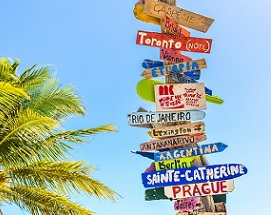It's time to visit the Old Continent, home of the royal family and one of the Seven Wonders of the World; The Colosseum in Italy, Europe, is one of the most visited continents in the world. With a population of 748 million, more than 200 languages are spoken in Europe. The world's second-smallest continent, Europe, comprises peninsulas west of Eurasia and accounts for about fifteen per cent of the world's total land area.
Divided into three distinct regions—Western Europe, Central Europe, and Eastern Europe—each is more attractive to tourists. With the Scottish Highlands in the northern part, the Hungarian Plains in the southern part, the mountains in Central Europe, and the Highlands in the southern region, the continent's fascination doubles with its diverse geographical division.
You can start your day in blissful Italy, where you head to Rome. The afternoon can be spent in quiet London where you have the London Eye, St. Paul's Cathedral, some of its beautiful tourist attractions waiting to welcome you. Spend the night in Paris by the Seine River and enjoy a starry night just below the Eiffel Tower.
So, are you the kind of person who is waiting to fulfil their lifelong dream of travelling to Europe but has cold feet? Well then, we're here to hold your hand and give you the courage to walk down the aisle of Europe. Let's explore all the great reasons to pack and book tickets to Europe.
| Europe Tourism |
Information |
| Official Language |
English, French, German |
| Also Known as |
the land of the Franks |
| Currency |
Euro (EUR) |
| Time Zone |
UTC+1 |
| Area |
10,180,000 Square kilometer |
| Best known for |
Eiffel Tower, Beaches and Islands |
| Things To Do |
Visit Churches And Cathedrals, Art Galleries And Museums And Shopping |
| Places To Visit |
Italy, Spain, France And United Kingdom |
Geography
Due to Europe's location in the Northern Hemisphere, it is popularly known as the Peninsula of Peninsulas. It is a combination of peninsulas and islands rather than large landmasses. With the continent's terrain and topography changing from one region to another, you will witness some scenic places when visiting Europe.
Water bodies such as the Black Sea, the Caspian Sea, the Mediterranean Sea, the Arctic Ocean, and the Atlantic Ocean surround this continent. Its geography can be divided into seven regions- the Scandinavian region comprising Norway, Iceland, Finland, Denmark, and Sweden, and the British Isles, including the United Kingdom and Ireland.
Central Europe covers Switzerland, Austria, Germany, Poland, Hungary, Slovakia, the Czech Republic, and Liechtenstein. The other regions are Western, Eastern, Southern, and South-Eastern Europe.
You will find several popular tourist destinations in France, Belgium, Spain, the Netherlands, Italy, and Monaco. Croatia, known for its scenic beauty, was featured as a backdrop in Game of Thrones.
The continent is separated from Asia in the east through the Aegean and the Black Sea.
Europe's notable highlands include the Black Forest, Vosges, and Ardennes in Germany, France, and Belgium, respectively, and the Scottish highlands. Central Europe is home to some of the most prominent national parks.
Our Europe tour packages are designed to offer the best travel experience. We combine the richness of delightful terrains with a variety of cuisines and comforts.
Europe's climate
Europe experiences a range of climatic conditions owing to its starkly different geography. Europe is vast, and each country has its seasons. Generally, however, the peak tourist season is from June to August. Long sunny days, mild climates in Northern Europe, and warm temperatures in Southern Europe often attract the most tourists in a year. Book early during this season, as prices go up. You may need to research the country you plan to visit to confirm general weather patterns. So choose the best time to visit Europe wisely.
Culture
Countries in Europe are a go-to destination for art, architecture, and historical relics connoisseurs. Here, artists have found their creative expression through music, films, architecture, visual arts, literature, philosophy, and economics. The era after the World Wars saw the growth of art deco and modernist architecture in Europe.
Our tourism in Europe guide suggests that you pay a visit to some long-standing cultural marks and immerse yourself in their history and beauty. Some culture-rich places you must add to your bucket list are:
- The Louvre and the Eiffel Tower in Paris
- Rome's open-air Opera
- The Spanish Steps
- The Colosseum
- Barcelona's La Sagrada Familia Church
- Austria's Vienna State Opera House
- Westminster Abbey in London
- Vienna's National Theater
Places to visit
Let us count down our picks for the top countries in Europe to visit. We are looking at the various European countries travellers should consider visiting for this list. In addition, we'll walk you through the distinct appeal of different countries across the continent, highlighting the destinations worth exploring and the most popular countries in Europe.
1. Georgia
Traditionally, this land that was once neglected by travellers worldwide at the crossroads of Eastern Europe and Asia is now getting the attention it deserves. Authenticity and unique culture top the list of priorities for modern travellers, and Georgia is in a good position in this regard. Its capital, Tbilisi, is a wonderful cultural hub with unique cuisine, inspiring and diverse architecture, and a long history. Shopping malls, a booming nightlife scene, producing chefs reviving high-end local dishes like khachapuri have fueled the city's growing popularity. The city is emerging without losing its presence and local conditions. With its diverse appearance and excellent skiing, the whole country is worth visiting.
2. Greece
Greece needs no introduction. The many Greek islands, each with their unique characteristics, make the region famous for beaches, sun worshipers, and new travellers. The food in Greece has a familiar palette and caters to diverse cuisine. This is one place in Europe where you will definitely find something new that you can appreciate and enjoy no matter how many times you visit.
3. Portugal
The Western European nation has long played a second game against its most famous neighbour, Spain. Still, with the number of bullets dwindling against excessive tourism in recent years, Portugal has finally got the love it deserves. On the downside, over-tourism has become an immediate problem here as well. However, no visit to Portugal is complete without a few days in Porto and Lisbon or Lisboa, which always have cultural attractions to appreciate, even if there are crowds. Portugal's long coast has many clean beaches, with smaller towns such as Tomar, Visio, and Monsanto attracting large groups of tourists with all the hallmarks of Portuguese charm.
4. Norway
The cost of living in Norway may be expensive, but there is no contradiction in living standards. In your time in the Scandinavian country, you will quickly understand why Norway remains one of the most exciting places in the world. Home to an estimated five and a half million people, Norway is peaceful, beautiful, and highly welcome. The beauty of the existing City buildings and the charms of the coastal cities surpass the splendour of the local landscape.
5. Italy
The endless appeal of Italy remains the same across bucket lists of people who are keen on travelling to Europe. Its vibrant history, friendship, local people, slow pace of life, expensive landscapes, and scenic views make Italy one of the most rewarding places to visit. You can focus on the less-visited southern Italy, where experienced travellers are welcome to get accurate and regional information about Italy.
How to get to Europe
Europe is accessible only by air. The flights vary from India to India, and several Indian cities have direct flights to European countries. Delhi, Mumbai, Bangalore, and Chennai offer thousands of daily flights from Air France, Aeroflot, Lufthansa, Finnair, Virgin Atlantic, and more. Flight duration is between 8-12 hours, and prices depend on when you choose to book your tickets.
Tourism tips for Europe
Here are some quick tips from our Europe travel guidelines that might come in handy when visiting the continent and ensure a smooth travel experience:
-
Check the visa requirements in detail and get all the information regarding the Schengen Visa.
-
When visiting any country in the European Union, secure a Eurail pass that will give you access to the inter-country rail travel that connects 28 nations across the continent.
-
Use local taxi and cab services which are readily available, safe, and run on a meter.
-
Make use of budget airlines such as Ryanair and EasyJet for intra-continental travel.
-
Travel during the offseason to the Mediterranean region to avoid overcrowding at beaches and other tourist attractions. It will also help save on accommodation, travel tickets, and other expenses.
-
Avoid adding multiple locations across the continent on your list for a single trip. Instead, explore one or two sites for a better travel experience.
-
Shop at the local markets to collect souvenirs for friends and family.
-
Visit off-beat destinations with local recommendations for an enriching travel experience.
FAQs
Our answers to some frequently asked questions will help you better prepare for Europe and make sure you have an enriching experience while visiting the region.
What should my daily cost be when travelling through Europe?
Although the daily travel costs can vary depending on your style of travel, budget travels to countries should cost between 50 and 80 Euros, excluding transportation. Travelling to Eastern Europe can be cheaper than the given budget.
Where should I get my currency exchanged when travelling in Europe?
You can exchange currency from any local banks that provide the service. You can look for the best exchange rates on your country's currency in Europe itself. You can also withdraw money from European ATMs using your debit or credit card that supports international transactions.
What are the benefits of a Schengen visa?
A Schengen visa allows you short trips of up to 90 days to member countries. Any visit beyond this time limit would require visa renewal.
Is the Euro applicable in all European countries?
No. Only 19 out of 44 countries in Europe use the Euro as their currency. Be sure to learn about the local currency and exchange rates before visiting.
Can you list the most affordable means of transportation when travelling to Europe?
For local transportation, buses are the cheapest. You can quickly secure a weekly pass. When visiting popular routes or sites, book your tickets a month in advance to get a reasonable rate.













